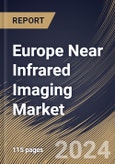Using near infrared spectroscopy and imaging, modifications caused by abnormal brain activity, injury, or disease can be identified by non-invasively measuring hemoglobin concentration and oxygenation in the brain, muscles, and other tissues. Furthermore, it enables investigations of subject populations using experimental paradigms that are not amenable to functional magnetic resonance imaging (fMRI) and provides measurements of both deoxygenated and oxygenated hemoglobin concentrations, thereby contributing to the field of brain research.
Imaging systems that integrate two modalities onto a single carrier are desirable for a variety of diagnostic applications (including tissue mapping during surgery) and functional imaging of oxygen distribution in tissue or enzyme activity. NIR emission, in contrast to the considerably narrower penetration depth of conventional fluorescent labelling, is positioned within the tissue window, thereby enabling optical imaging systems to detect tissue thicknesses ranging from one to three centimeters. In contrast to magnetic resonance imaging (MRI), the practical feasibility of activating near-infrared (NIR) dyes during surgical procedures is greater, suggesting that these systems may be advantageous in illuminating tissue requiring removal during the surgical process.
The British Association of Aesthetic Plastic Surgeons (BAAPS) reports that the most popular operations in the UK included brow lifting, liposuction, fat transfer, abdominoplasty, rhinoplasty, otoplasty, breast reduction, blepharoplasty, and blepharoplasty. Thus, it is anticipated that the market will develop as a result of an increase in surgical operations and public knowledge of these treatments along with the use of this method in numerous studies.
The Germany market dominated the Europe Near Infrared Imaging Market by Country in 2022, and would continue to be a dominant market till 2030; thereby, achieving a market value of $195.5 million by 2030. The UK market is registering a CAGR of 4.4% during (2023 - 2030). Additionally, The France market would showcase a CAGR of 6% during (2023 - 2030).
Based on Product, the market is segmented into Reagents (Indocyanine Green (ICG) and Others), Devices (Near-infrared Fluorescence Imaging Systems and Near-infrared Fluorescence & Bioluminescence Imaging Systems). Based on Application, the market is segmented into Preclinical Imaging, Cancer Surgeries, Gastrointestinal Surgeries, Cardiovascular Surgeries, Plastic/Reconstructive Surgeries, and Others. Based on End User, the market is segmented into Hospitals & Clinics, Pharmaceutical & Biotechnology Companies, and Research Laboratories. Based on countries, the market is segmented into Germany, UK, France, Russia, Spain, Italy, and Rest of Europe.
List of Key Companies Profiled
- Medtronic PLC
- Stryker Corporation
- Olympus Corporation
- Hamamatsu Photonics K.K.
- Carl Zeiss Meditec AG (Carl Zeiss AG)
- PerkinElmer, Inc.
- Leica Microsystems GmbH (Danaher Corporation)
- Shimadzu Corporation
- Karl Storz SE & Co. KG
- Fluoptics SAS
Market Report Segmentation
By Product- Reagents
- Indocyanine Green (ICG)
- Others
- Devices
- Near-infrared Fluorescence Imaging Systems
- Near-infrared Fluorescence & Bioluminescence Imaging Systems
- Preclinical Imaging
- Cancer Surgeries
- Gastrointestinal Surgeries
- Cardiovascular Surgeries
- Plastic/Reconstructive Surgeries
- Others
- Hospitals & Clinics
- Pharmaceutical & Biotechnology Companies
- Research Laboratories
- Germany
- UK
- France
- Russia
- Spain
- Italy
- Rest of Europe
Table of Contents
Companies Mentioned
- Medtronic PLC
- Stryker Corporation
- Olympus Corporation
- Hamamatsu Photonics K.K.
- Carl Zeiss Meditec AG (Carl Zeiss AG)
- PerkinElmer, Inc.
- Leica Microsystems GmbH (Danaher Corporation)
- Shimadzu Corporation
- Karl Storz SE & Co. KG
- Fluoptics SAS
Methodology

LOADING...








